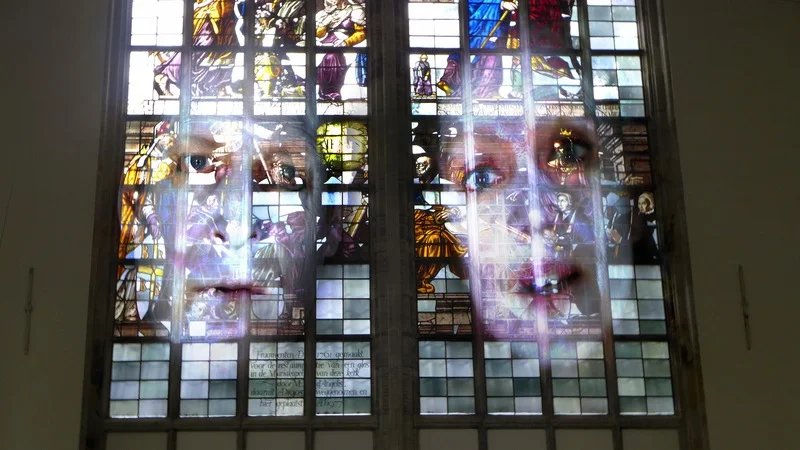Tony Oursler hacks a church with reverse iconoclasm
By Edo Dijksterhuis
December 2, 2014
Tony Oursler: I/O underflow
True to their sometimes petty nature and deep-seated adversity to change the town folk of Amsterdam were up in arms last year when Jacqueline Grandjean made public her plans for the Oude Kerk (Old Church). The new director wanted the venue to become more than a glorified exhibition space filled with penurious looking temporary bulkheads. She envisioned large-scale installations by artists of international repute, in interviews casually mentioning the Unilever Series in Tate Modern’s Turbine Hall as a benchmark. In terms better reserved for the hooligans and drunken tourists roaming the surrounding red light district, local residents spoke out against what they feared would become "a spectacle." Emotions ran high in readers' letters to the local newspaper as if Grandjean were proposing to set fire to Amsterdam’s oldest building. All these protestors should now go and visit Grandjean’s maiden exhibition to find out that not only has the integrity of the 1306 monument been preserved, but the place has actually been injected with new energy.
Tony Oursler provides the star power necessary for a flying start of the new Old Church. In the early eighties the American pioneered what was then called multi-media art with elaborate installations combining video, sound, language and sculpture. He ran with the CalArts crowd of the day, even playing in a band with the late Mike Kelley, and collaborated with David Bowie. His list of exhibitions is sheer endless but Systems of Dramatic Feedback in 1995 was his last solo show in The Netherlands. For Oude Kerk's I/O underflow, his long overdue re-acquaintance with a country that was amongst the first to appreciate his art, he has made four new works. Oursler worked site-specifically, reacting to the seven-century-old architecture or—as he puts it himself in the exhibition brochure—"hacking the church."
For the younger generation new to Oursler’s work there’s the opportunity to get up to speed in the period rooms adjacent to the main space. The oldest work, X-doll from 1992, which is presented in the holy sepulcher, features a restless, spread-eagled nude figure projected on a cross. This combination of projection and three-dimensional objects is vintage Oursler and is further refined in Orbit (2007), a snake-like figure inhabiting the marble sculpture of a giant knot. An example of the evil-looking dolls with animated faces, which Oursler first presented at Documenta 9 and were popular for a while at international art fairs, can be found in the mirror room. AndTalking Light (2014), a large lightbulb flickering in time with a speech delivered by the artist himself, echoes the 1997 key work Streetlight.
The four new works are large-scale projections dealing with the themes that have run like a thread through Oursler’s work since the turn of the century: virtual imagery, the relationship between man and machine, and the power of media in shaping our experiences and thoughts. Using the human figure in a theatrical way, mostly as moving portraits, Oursler questions the authenticity and integrity of digital representation. Here, digital technology and human subjectivity, face and interface, clash and mix. This is very explicit in Jim Fletcher, Jason Scott, in which a ghostly Jim symbolizes the computer unable to fully represent humans (and obviously ill at ease with this fact); meanwhile actor Jason spits out names of computer viruses as if he himself is fatally infected with digilitis.
The work, laced with fragments of Christian prayers, is projected high on a wall, next to a round window depicting a dove carrying an olive branch back to Noah’s Ark. It adds an extra layer to the work: fear for a virtual Deluge but also the promise of rebooting humanity with a clean slate. With a kind of reverse iconoclasm, Oursler cleverly plugs into the historic and religious, echoes and images bouncing off the church walls, the vaulted ceiling, and stained glass windows. Moreover, by enriching the architecture with his projections he also makes you look closer at it, reactivating the space which for a long time was mostly seen through the eyes of tourists.
In the central piece of the show, Holly Stanton/Josie Keefe, Jim Fletcher/Kate Valk, two couples take turns delivering a fragmented narrative. The work was inspired by the Turing Test, devised by the British mathematician Alan Turing, who is generally considered the grandfather of computer science. Its aim is to test whether a computer is impersonating a human. At first the older, robot-like couple seems to fit the bill perfectly, but along the way they become more warm-blooded and dramatic. At some point an apple appears and the woman eggs on the man to "make a wish and take a bite." It’s an explicit reference to Turing who, upon being found out as a homosexual, committed suicide by eating a poisoned apple. But Snow White and, naturally in this consecrated context, Eve’s original sin come to mind just as quickly.
Although the projections are massive, they are not at all intrusive. The monumental space easily stands up to them, transcends the role of temporary canvas by being a partner in dialogue. I/O underflow raises expectations for what’s to come, interventions by the likes of Tatzu Nishi and Susan Philipsz. It’s the kind of spectacle a city can never have too much of.


